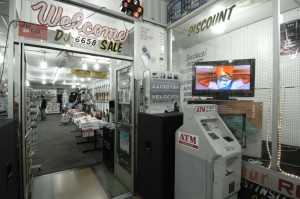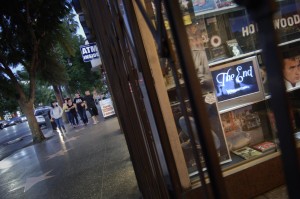A carefully constructed placement of a screen can bring a difficult piece of video art into a framework that becomes comprehensible to the uninitiated.Place itself can serve as a segue between the known location and the unknown art. The tattoo parlour can reframe a graffiti video; the burrito restaurant offers a homespun context to watch a Katrina documentary; a gem of animation makes sense in a jewellery store window; a morose story about a father becomes more poignant playing inside a men’s suit store; a gender program looping all day in an erotic supply store window adds irony; a suburban deconstruction piece inside a rough urban pizza parlour increases its power. Screen placement transfers meaning.
Every two years a newly re-invented LA Freewaves Festival presents experimental films, artist videos, net art and new media formats across multiple Los Angeles sites ranging from established venues such as the Getty and MOCA to alternative spaces such as karaoke clubs, video billboards, video bus tours and storefronts. The 2008 version just completed their live, free portion called Hollywould, along six blocks of wondrous Hollywood Boulevard, a street with a big façade, a fabricated history and 20 different demographics. The advertising and mass media-saturated environment challenged Freewaves and viewers as it offered free viewings of 200 videos from 30 countries on TVs, monitors and DVD players at 30 stores and restaurants throughout the city.
Additionally, new art videos were shown on 2,200 Transit TV buses throughout Los Angeles, a shopping mall showed an artist’s animation on their streetside LED sign and guerrilla actions questioned the appropriation of media for surveillance and Hollywood’s responsibilities in an electronically meshed world.
The undertaking was epic: two years of community immersion; cajoling businesses; endless fundraising; curation spanning every continent; and almost daily culture shock opened the doors of 40 businesses, restaurants, bars, hotels and even arts facilities to experimental film, video and new media. The famous/infamous, upscale/down-trodden Boulevard was transformed into a screening room, cross-referencing the entertainment industry’s myths and facades with the reality of a Los Angeles neighbourhood very much in flux.

“At the Light of Dawn” by Ivan Limas shown in the window of High Tech Electronics store. Credits: Douglas McCulloh.
Did the Boulevard regulars of business owners, club-goers, tourists, streetwalkers, runaways and workers find Hollywould transformative and stimulating? Not necessarily. Were artists enthusiastic about showing their works at tattoo parlours and porn shops? Not universally. So why bother to go the extra thousand hours of labour to display new media in public venues for a potentially icy response? Well, of the 166,000 Boulevard pedestrians, enough people from all nationalities and walks of life got their first exposure and reacted positively to artist-made media… enough to raise hopes that the general public is emerging from a half-century of TV stupor and seeking alternatives beyond the soporifics of couch-delivery entertainment.
Information spreads depending on how culture treats it. Musicians’ files are already circulating widely via the Net because they are small files. Soon I hope artists’ visuals will too, helping to spread alternative meanings across our many borders – linguistic, geopolitical and psychic. The concurrence of civil rights, postmodernism, Internet, gender bending, hybridity, gay/lesbian/trans/bi rights and postcolonial movements bodes well for including more views and styles. Decentralisation is a major trend in many fields, despite the fact that in the USA, as few as six companies own 97% of all distributed images, text and music. Social movements precede political movements; we are connected and therefore strong for the first time.
The qualities that define much of video art today — frank sexuality, profanity, nudity, lack of credits, appropriated footage, low-tech production styles — are not allowed on television. Are art, ideas and new aesthetics for everyone or just the museum goers? For me, curating involves actively seeking out new work but also circulating it beyond its original communities and venues. We find that audiences are most receptive to experimental work when it is presented thematically and mixed with other genres, suggesting that there are many ways to tell new stories.
So, is the fellow shopper next to you on a busy boulevard looking so intently at the merchandise or the art?
Anne Bray
Anne Bray is an artist, teacher and Executive Director of Freewaves, a media arts organisation and festival in Los Angeles. She developed the concept of the multi-cultural network based on exchange through the media arts in 1989 and has continued to see the organisation through the technological, social and aesthetic changes of the 1990s to now.
Bray’s educational experience includes photography history at the Bibliotheque Nationale in Paris, new technology art with MIT artists and new genres at University of California Los Angeles (UCLA, MFA, 1985), giving her the conceptual framework to posit media arts as public art.
As an artist she exhibits her own work as temporary installations in public sites and art venues combining personal and social positions via video, audio, slides and 3D screens at gas stations, malls, movie theatres, on TV, in department stores and on billboards. She has also produced mixed media installations and performances at Santa Monica Museum of Art and elsewhere.As a lecturer, Bray teaches graduate seminars in the new genre arts at Claremont Graduate University, plus public art and multimedia at University of Southern California.
Read More
Watch More
 This work is licensed under a Creative Commons Attribution-NonCommercial-ShareAlike 2.5 Australia.
This work is licensed under a Creative Commons Attribution-NonCommercial-ShareAlike 2.5 Australia.









Great article. Please check a similar project that took place recently in guayaquil, ecuador: http://www.facebook.com/album.php?aid=135842&id=702359574&ref=mf
regards,
x. andrade, chairman-for-life, full dollar corp.
http://www.laselecta.org/archivos/full-dollar/actividades.html
fulldollarenestrechodudoso.blogspot.com